|
|
Venus Facts

Image of the planet taken by the Pioneer Venus Orbiter in 1979.
Planet Venus Facts
- Venus is the second planet from the sun and very similar in size to the Earth, its diameter is only 400 miles (644 km) smaller than Earth.
- At its closest point to Earth the planet is a mere 24 million miles away (38 million km).
- Venus orbits the sun at an average distance of 67 million miles (108 million km).
- The planet orbits around the sun every 225 days but rotates on its own axis slower than any other planet, taking 243 days compared to 24 hours on Earth, meaning a day on Venus is longer than its year!
- Venus is surrounded by extremely thick cloud making it impossible to see the surface from orbit without radar or radio equipment.
- The force of gravity on Venus is only 12% less than we have on Earth but the extreme weight of atmospheric pressure would crush a human.
- Venus rotates on its axis in the opposite direction to the other planets of the solar system.
- Apart from the moon Venus is the brightest object in the night sky.
- Venus was the first planet to be observed by a passing spacecraft.

A Magellan satellite radar image of the Venusian volcano Maat Mons.

An image captured from the Venusian surface, taken by a Russian probe in 1982.
Venus Surface
Most of the Venusian surface is covered by flat plains but it also has mountains, canyons and valleys. There are thousands of
volcanoes on Venus, some up to 150 miles (240 km) in diameter and evidence strongly suggests that volcanic activity is stll ongoing on the planet.
Venus also has huge ring-like structures called coronae dotted across its surface, these are lava domes that have flattened out over time.
One of the strangest aspects of the surface of Venus is the lack of very many craters, meaning that the geology of the planet is relatively young.
It is thought that every few hundred million years Venus undergoes massive global resurfacing, in essence the entire surface turns into molten lava then
cools creating a new crust.
Venus Atmosphere
The atmosphere of Venus is over 90 times heavier than that of Earth producing crushing surface pressure,
it consists mainly of carbon dioxide with small amounts of nitrogen and water vapor.
Lightning occurs in the upper atmosphere along with clouds of sulfur dioxide which produce sulfuric acid rain.
Venus Temperature
Extremely hot! The temperature at the uppermost clouds of Venus average about 13C (55F) however the surface temperature is a baking 465C (870F), the hottest surface
of any planet in the solar system.
Moons
Venus has no moons.
Life on Venus
Due to the extreme heat it is highly unlikely any lifeforms could exist on the surface, airborne life forms could exist in temperate high clouds.
Origin of Name
The planet was named by the Romans after the Goddess of Love.
Venus, Earth's Twin?

Artist's impression of the surface of Venus.
The atmospheres of both worlds are very different, Earth’s is thin and nitrogen based whereas the atmosphere on Venus is extremely thick and composed almost entirely of carbon dioxide. Ninety percent of Earth’s atmosphere is within just 6 miles (10 km) of its surface, on Venus it would be 30 miles (50 km) from its surface before reaching 90% of its atmosphere. As a result atmospheric pressure on Venus is a massive 90 times stronger than on Earth, this is the same pressure you would feel if you were a kilometer under the ocean, although you wouldn't feel it for very long as you would be instantly crushed. Perhaps the biggest difference is the intense heat, surface temperatures can reach an incredible 465C (870F) which is hot enough to melt lead. So where did it all go wrong for our twin planet? Well unfortunately it was just too close to the sun. The water it once had flowing across its surface quickly evaporated and without the cleansing effect of rain huge amounts of carbon dioxide built up in its atmosphere from intense volcanic activity. This created a runaway greenhouse effect, our twin reached the point of no return ending up with the hottest surface temperature of any planet in the solar system.
Animation using radar images of the Venusian surface
Missions to Venus
Venus Express
 Launch: November 2005
Launch: November 2005Arrival: April 2006
Agency: ESA (Europe)
Summary: Venus Express is currently in orbit around Venus and has indicated that the planet is still volcanically active
Magellan
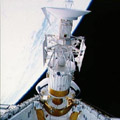 Launch: May 1989
Launch: May 1989Arrival: August 1990
Agency: NASA
Summary: By the end of its mission Magellan had mapped 98% of the planet using advanced radar techniques.
Vega 1
 Launch: June 1983
Launch: June 1983Arrival: October 1983
Agency: Soviet Union
Summary: Vega 1 deployed a probe into the planet's atmosphere which measured temperature, pressure and wind velocity.
Venera 15 and 16
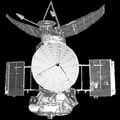 Launch: June 1983
Launch: June 1983Arrival: October 1983
Agency: Soviet Union
Summary: Venera 15 and 16 created a radar map of the planet over a joint mission lasting 8 months.
Venera 14
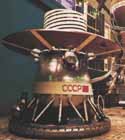 Launch: November 1981
Launch: November 1981Arrival: March 1982
Agency: Soviet Union
Summary: Venera 14's lander successfully touched down on the planet's surface sending back 14 images and a mechanical arm collected a sample for testing. The craft survived for 57 minutes before finally succumbing to the intense pressure. (Lander pictured left).
Venera 13
 Launch: October 1981
Launch: October 1981Arrival: March 1982
Agency: Soviet Union
Summary: Venera 13's lander successfully touched down sending back the first color images of the surface. It also collected and examined a sample with a mechanical arm. The craft survived for 2 hours before succumbing to the extreme heat and pressure. (Orbiter pictured left).
Venera 11 and 12
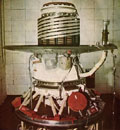 Launch: September 1978
Launch: September 1978Arrival: December 1978
Agency: Soviet Union
Summary: Both landers successfully touched down on the surface sending back data about the atmospheric composition and clouds of the planet, evidence of thunder and lightning as well as the presence of carbon monoxide.
Pioneer Venus 2
 Launch: May 1978
Launch: May 1978Arrival: December 1978
Agency: NASA
Summary: Pioneer Venus 2 consisted of four separate atmospheric probes. Each probe took atmospheric measurements as they descended through the cloud layer. One of the probes survived to transmit data for over an hour after it impacted with the surface.
Pioneer Venus 1
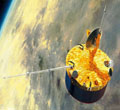 Launch: May 1978
Launch: May 1978Arrival: December 1978
Agency: NASA
Summary: Used radar to map most of the planet. The spacecraft remained in orbit until August of 1992, when it used up all its fuel and burnt up in the atmosphere.
Venera 10
 Launch: June 1975
Launch: June 1975Arrival: October 1975
Agency: Soviet Union
Summary: Successfully landed a probe on the planet. It transmitted images from the surface and sent back data about clouds and the surface environment.
Venera 9
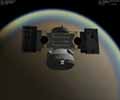 Launch: June 1975
Launch: June 1975Arrival: October 1975
Agency: Soviet Union
Summary: Successfully landed a probe on the planet's surface. It became the first spacecraft to transmit a picture from the surface of another planet. Also sent back data on the Venusian clouds, atmospheric composition, and light levels.
Venera 8
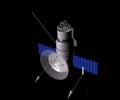 Launch: March 1972
Launch: March 1972Arrival: July 1972
Agency: Soviet Union
Summary: Successfully landed a probe on the planet's surface. The probe transmitted data for 50 minutes, confirming a very high surface temperature and crushing atmospheric pressure.
Venera 7
 Launch: August 1970
Launch: August 1970Arrival: December 1970
Agency: Soviet Union
Summary: Successfully landed a probe on the planet's surface. The probe became the first spacecraft to return data from the surface of another planet. It reported surface temperatures of 475°C and atmospheric pressures 90 times greater than Earth's.
Venera 5 and 6
 Launch: January 1969
Launch: January 1969Arrival: May 1969
Agency: Soviet Union
Summary: Venera 5 and 6 descended into the Venusian atmosphere sending back data for just over 50 minutes before succumbing to the intense pressure.
Mariner 5
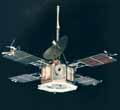 Launch: June 1967
Launch: June 1967Arrival: October 1967
Agency: NASA
Summary: Flew within 4000 miles (2,400 km) of the planet measuring a surface temperature of 267C.
Venera 4
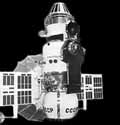 Launch: June 1967
Launch: June 1967Arrival: October 1967
Agency: Soviet Union
Summary: Dropped several instruments into the atmosphere before descending itself. It revealed an atmosphere made up almost entirely of carbon dioxide, extremely high temperatures and atmospheric pressure.
Mariner 2
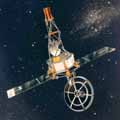 Launch: August 1962
Launch: August 1962Arrival: December 1962
Agency: NASA
Summary: Mariner 2 was the first spacecraft to successfully fly by the planet. It detected ground temperatures as high as 428C (800F). Radio contact was lost on January 3, 1963.

A radar image of Venus captured by NASA's Magellan spacecraft.
Planet Venus Statistics
Diameter: 7,521 miles (12,104 km)Average Distance from Sun: 67 million miles (108 million km)
Orbital Period: 225 days
Rotation Period: 243 days
Maximum Surface Temperatures: 465C (870F)
Minimum Surface Temperatures: same as maximum
Gravity: 8.87 m/s2 (91% Earth's Gravity)
Density: 5.24 g/cm3 (95% Earth's Density)
Mass: 4.8685 x 1024 kg (81.5% Earth's Mass)
Volume: 9.284 x 1011 km3 (88% Earth's Volume)
Atmosphere: 96% Carbon dioxide, 3.5% Nitrogen, 0.015% Sulfur dioxide, 0.007% Argon, 0.002% Water vapor, 0.001 7% Carbon monoxide, 0.001 2% Helium,
0.000 7% Neon.
Share this page
Related Pages